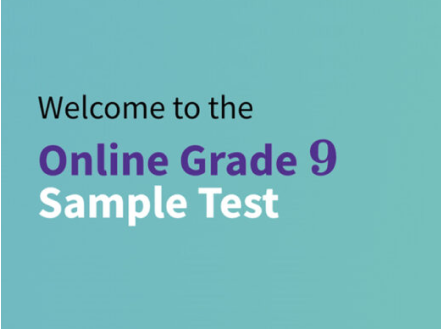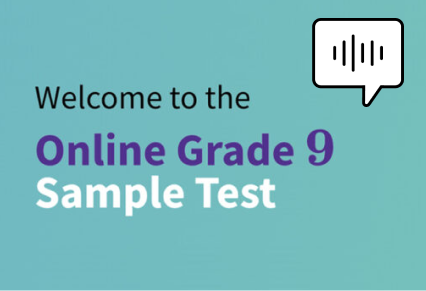Grade 9
Assessment of Mathematics

Description
The Grade 9 Assessment of Mathematics tests the mathematics knowledge and skills students are expected to have learned by the end of the Grade 9 mathematics course.
Administration Dates
Winter Administration
Assessment of Mathematics
Wednesday,
January 7, 2026
6:00 a.m. (ET)

Friday,
January 30, 2026
6:00 p.m. (ET)
* Individual student results will be reported after each student has completed the assessment.
Spring Administration
Assessment of Mathematics
Thursday,
May 28, 2026
6:00 a.m. (ET)

Wednesday,
June 24, 2026
6:00 p.m. (ET)
* Individual student results will be reported after each student has completed the assessment.
Administration User Guide, 2024–2025
This online user guide provides direction and information to teachers, school administrators and IT professionals at schools and boards who are involved in the administration of the Grade 9 Assessment of Mathematics.
The user guide covers key topics for
1.
Teachers
Includes accessing accounts, managing classes, preparing students for assessment sessions, and administering sessions and stages.
2.
School administrators
Includes accessing and navigating accounts as well as managing student lists, teacher accounts and upcoming assessment sessions at the school.
3.
School board representatives and IT teams
Includes the technical readiness process, accessibility and accommodation options, bandwidth and connectivity requirements, security and domain allowed-list protocols as well as information on the configuration of devices.
*For technical support, please e-mail our technical support team at [email protected] or call 1-888-327-7377 (Ontario only) or 416-916-0708 (outside Ontario).
Framework
Students enrolled in the MTH1W Grade 9 de-streamed mathematics course are learning the knowledge and skills that are defined in the expectations found in the 2021 Ontario Grade 9 mathematics curriculum. EQAO’s Grade 9 Assessment of Mathematics assesses student learning of the content in this curriculum. The Grade 9 Assessment of Mathematics Framework provides a detailed description of the assessment, including how the assessment is mapped to the Ontario mathematics curriculum. The “At a Glance: Grade 9 Assessment of Mathematics” document is a one-page summary of the key details of the assessment.
At a Glance
Assessment of Mathematics
Grade 9
Framework
Assessment of Mathematics Framework
Grade 9
Resources for Teachers and Students
Released Questions
This resource is provided to support educators with the EQAO Grade 9 Assessment of Mathematics. This publication includes the definitions of the categories of knowledge and skills as well as adapted assessment questions to serve as examples. Detailed information about each question, including the overall expectation and the category of knowledge and skills to which the question is mapped, are provided.
The 2024 released questions resource includes provincial data for each question. The data shows the percentage of students who selected each answer choice by level.
Released Questions, 2024
Assessment of Mathematics
Grade 9
Released Questions, 2023
Assessment of Mathematics
Grade 9
English–French and French–English Glossaries
The glossaries are intended for French Immersion students to use during the assessment. However, the glossaries are available in the e-assessment platform for all students. Students can also have access to a hard copy of the glossaries. Both the English–French and French–English glossaries contain many common mathematical terms used in French and English on the assessment.
Glossaries
Assessment of Mathematics
Grade 9
Glossaries: Large Print
Assessment of Mathematics
Grade 9
Formula Sheet
Mathematical formulas are provided on the formula sheet for students’ reference during the Grade 9 assessment. Formulas are given for the area of various geometric shapes.
Formula Sheet
Assessment of Mathematics
Grade 9
Formula Sheet: Large Print
Assessment of Mathematics
Grade 9
What to Expect on the Assessment
This video will provide information on what students can expect when participating in the Grade 9 Assessment of Mathematics.
View transcription.
Welcome. This video will provide information on what students can expect when participating in EQAO’s Grade 9 Assessment of Mathematics.
EQAO assessments provide parents, guardians and educators with information about student attitudes and achievement in literacy and numeracy in Ontario’s education system. The information provided assists policy-makers and researchers in making decisions about and supporting continuous improvement in students’ learning.
The Grade 9 Assessment of Mathematics is administered near the end of the Grade 9 mathematics course. Educators have the flexibility to determine when assessment sessions will be scheduled within the administration windows set by EQAO.
EQAO assessments have been modernized to allow for a more engaging and student-focused experience. Students will complete the online assessment at school.
The questions in the assessment align with the expectations in The Ontario Curriculum and measure the knowledge and skills students are expected to have learned by the end of the Grade 9 mathematics course.
The assessment consists of questions that cover students’ knowledge and skills in the following strands: Number, Algebra, Data, Geometry and Measurement, and Financial Literacy.
Although the assessment does not measure the content in the Mathematical Thinking and Making Connections strand, students will be required to apply the mathematical processes while completing the assessment.
The Grade 9 Assessment of Mathematics is an online assessment that includes two sessions—Session A and Session B. Each session has two stages and is designed to be completed in approximately 60 minutes. The assessment uses a multi-stage computer adaptive testing model that adapts to individual students’ performance as they progress through each assessment session.
At the end of the two assessment sessions, students will complete a voluntary questionnaire that asks them about their attitudes and perceptions with respect to mathematics and their learning environment. EQAO will use this data to provide schools, boards, teachers and parents and guardians with information on how student attitudes and perceptions are related to students’ mathematics achievement.
Students will have an opportunity to participate in an introductory session of the assessment with their teacher. This will help familiarize them with the online e-assessment platform.
During this introductory session, students will complete a sample test and tool exploration, where they can try out the tools that will be available during the assessment, such as the tool for drawing lines, the highlighter tool and the eraser tool.
All students can also use the assessment’s built-in accessibility tools, including the line reader, the zoom-in and zoom-out features, a text-to-speech reader and a high-contrast mode.
A built-in calculator is also provided. The EQAO formula sheet, which includes mathematical formulas students may require during the assessment, and the EQAO English–French and French–English glossaries are also available in the e-assessment platform. Students can have hard copies of the glossaries to use during the assessment.
Students are also allowed to use their own calculator (scientific or graphing) and a pencil and paper for rough work during the assessment.
Before completing the assessment, students also have access to reminders of test-taking strategies, and relaxation and visualization activities to help them stay calm and focused. There are a variety of question types that students may complete during the assessment, such as single-selection, multiple-selection, drag and drop, and drop-down menu questions.
Anyone who would like to become familiar with the format of the Grade 9 Assessment of Mathematics, and the types of questions that may be included in the assessment, can refer to the sample test on EQAO’s website.
Since the assessment is aligned with The Ontario Curriculum, which is used for classroom instruction, the Grade 9 Assessment of Mathematics does not require additional preparation.
A framework document that provides a description of the Grade 9 Assessment of Mathematics, including what is assessed and the assessment design, is available on EQAO’s website. The framework also includes an assessment blueprint that shows how many questions students complete from the different strands of the Ontario Grade 9 mathematics curriculum.
Individual Student Reports (or ISRs) are made available to teachers after the completion of the assessment sessions. Students will receive their report from their teacher to bring home.
The ISRs provide information about each student’s achievement on the assessment. Results of this assessment are to be included as part of a student’s final course mark as per the Ministry of Education’s Growing Success: Assessment, Evaluation and Reporting in Ontario Schools document and its addenda.
This information enables students, parents and guardians and teachers to plan for improvement. Please visit www.eqao.com to learn more about the Education Quality and Accountability Office.
Sample Test
Familiarization with the Online Assessment
This sample test gives students the opportunity to become familiar with the online assessment and its platform. Students will be able to try out the various tools, including built-in text-to-speech audio, zoom in and zoom out, high contrast and the highlighter, in the e-assessment platform.
Various Question Types
This sample test also provides students with the opportunity to respond to the various types of questions, including drag-and-drop, drop-down menu and single- and multiple-selection questions, that may be included on the assessment.
Assessment Structure
During the assessment, students complete two sessions with four stages; the sample test consists of one session with two stages, and a total of 27 questions.
Alternative Version of the Sample Test
These two formats for the alternative version of the sample test should be used for students who have special education needs or special circumstances and who require specific accommodations that are not compatible with the adaptive assessment. These formats of the alternative version of the sample test contain one session with a total of 25 single-selection questions.

Sample Test
Grade 9 students can become familiar with the digital assessment and its platform through our sample test.
Grade 9
Note: Revised 10.02.24

Sample Test
Alternative Version Including Audio with Full Descriptions of Mathematics Graphics
This format of the alternative version is for students with a visual impairment (including students who require the Braille format) and who require audio with full descriptions of all mathematics graphics.
Grade 9

Sample Test
Alternative Version Including Audio Without Full Descriptions of Mathematics Graphics
This format of the alternative version is for students who are able to respond only to single-selection questions, or who require the printable PDF, and who do not require audio with full descriptions of all mathematics graphics.
Grade 9
If you require the alternative version of the sample test in a different format, including contracted or uncontracted Braille, e-mail EQAO at [email protected].
Live Webinars
More to explore

Publications
EQAO: A Guide for Parents and Guardians
Find answers to your EQAO questions in one simple, friendly guide.
Grade 3
Grade 6
Grade 9
OSSLT

Infographics: Assessments
Permitted Items for the Grade 9 Assessment of Mathematics
Are you about to participate in the Grade 9 Assessment of Mathematics? Here’s a list of common items you can use in addition to the supports and tools built into our e-assessment platform.
Grade 9
Assessments

Research Report
EQAO Fall #DataInAction Symposium 2024
School board staff from across the province joined EQAO for its fourth #DataInAction symposium to discuss key trends in mathematics achievement. Learn more in this summary
Grade 9
Symposium

Infographics: Research
Grade 9 Infographic of the Provincial Results, 2023–2024
Students in English-Language Schools
Grade 9

Publications
Grade 9 Highlights of the Provincial Results, 2023–2024
Students in English-Language Schools
Grade 9

Infographics: Research
Mathematics Trends at a Glance: A Look at Three Years of EQAO Data, English-Language Schools
Explore trends in mathematics among students in English-language schools from 2021–2022 to 2023–2024.
Grade 3
Grade 6
Grade 9
Trends

Infographics: Research
Mathematics Trends at a Glance: A Look at Three Years of EQAO Data, French-Language Schools
Explore trends in mathematics among students in French-language schools from 2021–2022 to 2023–2024.
Grade 3
Grade 6
Grade 9
Trends

Infographics: Assessments
At a Glance: Grade 9 Assessment of Mathematics
Check out this handy infographic, designed to give you key insights into the Grade 9 Assessment of Mathematics.
Grade 9
Assessments

Infographics: Assessments
Behind the Scenes of an EQAO Assessment: Questions, Questions, Questions!
Check out this handy infographic, designed to give you insights into how questions are created for an online EQAO assessment.
Assessments

Infographics: Assessments
Understanding the provincial standard and the levels of achievement
EQAO’s assessments measure the literacy and mathematics skills that students are expected to have learned at specific times in their kindergarten to Grade 12 education.
Assessments

Publications
EQAO: A Guide for Parents and Guardians
Find answers to your EQAO questions in one simple, friendly guide.
Grade 3
Grade 6
Grade 9
OSSLT

Infographics: Assessments
Permitted Items for the Grade 9 Assessment of Mathematics
Are you about to participate in the Grade 9 Assessment of Mathematics? Here’s a list of common items you can use in addition to the supports and tools built into our e-assessment platform.
Grade 9
Assessments

Research Report
EQAO Fall #DataInAction Symposium 2024
School board staff from across the province joined EQAO for its fourth #DataInAction symposium to discuss key trends in mathematics achievement. Learn more in this summary
Grade 9
Symposium

Infographics: Research
Grade 9 Infographic of the Provincial Results, 2023–2024
Students in English-Language Schools
Grade 9

Publications
Grade 9 Highlights of the Provincial Results, 2023–2024
Students in English-Language Schools
Grade 9

Infographics: Research
Mathematics Trends at a Glance: A Look at Three Years of EQAO Data, English-Language Schools
Explore trends in mathematics among students in English-language schools from 2021–2022 to 2023–2024.
Grade 3
Grade 6
Grade 9
Trends

Infographics: Research
Mathematics Trends at a Glance: A Look at Three Years of EQAO Data, French-Language Schools
Explore trends in mathematics among students in French-language schools from 2021–2022 to 2023–2024.
Grade 3
Grade 6
Grade 9
Trends

Infographics: Assessments
At a Glance: Grade 9 Assessment of Mathematics
Check out this handy infographic, designed to give you key insights into the Grade 9 Assessment of Mathematics.
Grade 9
Assessments

Infographics: Assessments
Behind the Scenes of an EQAO Assessment: Questions, Questions, Questions!
Check out this handy infographic, designed to give you insights into how questions are created for an online EQAO assessment.
Assessments

Infographics: Assessments
Understanding the provincial standard and the levels of achievement
EQAO’s assessments measure the literacy and mathematics skills that students are expected to have learned at specific times in their kindergarten to Grade 12 education.
Assessments
FAQs
Answers to Our Most Frequently Asked Questions
What is the format of the Grade 9 Assessment of Mathematics?
The Grade 9 Assessment of Mathematics is an online assessment that includes two sessions (Session A and Session B), totalling 54 questions (50 questions that are used to determine a student’s outcome and four field-test questions). Each session has two stages and is designed to be completed in approximately 60 minutes. The sessions (Session A and Session B) can be completed one after the other, either back to back with a break in between, or on two different dates and times. Schools consider the needs of the students and operational needs of the school to determine the schedule for writing each session in one continuous, supervised sitting.
The assessment uses a multi-stage computer adaptive testing model that adapts to individual students’ performance as they progress through each assessment session.
More information on the test design can be found in the Framework.
For more information on the scoring of the Grade 9 Assessment of Mathematics, please refer to the test’s Framework. For more information on the provincial standard and the levels of achievement, please refer to this resource.
How is a student outcome determined?
A student’s outcome is assigned using a statistical procedure that takes into account the student’s responses to all the operational questions on the assessment and the difficulty of each of these questions. This procedure, known as Item Response Theory (IRT), assumes a continuum of ability in knowledge and skills (as reflected by the achievement level 1 to 4), and locates the student’s outcome along that continuum.
Can I see my child’s assessment?
Individual completed assessments and student responses cannot be released to the public since questions are kept for use in future assessments. If you are seeking feedback to help improve your child’s success, your child’s teachers will likely have the best insight into the areas that they could improve in to meet the expectations set out in the Ontario Grade 9 mathematics curriculum.



